Table of contents
- Technology: BMW six-cylinder Interview with the developers of the six-cylinder
- The six-cylinder performance
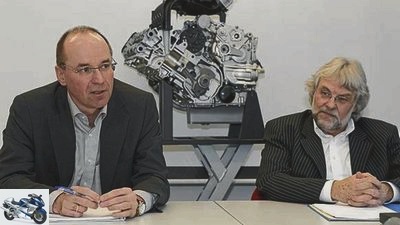
Bilski
counselor
technology & future
Technology: BMW six-cylinder
Technology: BMW six-cylinder
Interview with the developers of the six-cylinder
More than thirty years after Benelli, Honda and Kawasaki, the next straight six comes from BMW of all places. MOTORRAD spoke to the people behind this drive, Wolfgang Mattes and Heinz Hege.
Stefan Kaschel
02/03/2011
? Mr. Mattes, Mr. Hege, when did the plan for the six-cylinder mature??
! Hege: With reflections on one “Super tourer”, as we called it, we started at the end of 2003, whereby the six-cylinder was one of many concepts that we had considered. At that time, we were also thinking about engines with a displacement well over two liters. There were also attempts to boost the existing four-cylinder engine in order to generate more torque and more sovereignty. But that didn’t seem to be the right way to go. But there was also resentment towards the six-cylinder concept at the beginning. Too big, too heavy. We then just developed a concept in which we primarily looked at the overall width. The overall width of the six-cylinder in this installation position equals freedom of inclination. And then of course there is the weight.
Buy complete article
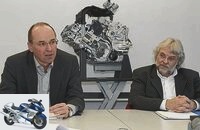
Technology: BMW six-cylinder
Interview with the developers of the six-cylinder
6 pages) as PDF
€ 2.00
Buy now
? But by then the decision for the six-cylinder had already been made?
! Hege: No, not until we got that done. When we said it could look like that, that could come out, that would be okay.
? Until then, this concept ran alongside other concepts?
! Mattes: I think when you make such a decision, you first create basic requirements for what the engine and vehicle should be able to do. Then there are usually several alternatives, which are checked in the context of package investigations with regard to the functional properties, so that one finally comes to the choice of the concept.
? And then so much spoke in favor of the six-cylinder?
! Hege: Right, yes, considering that we wanted a very confident vehicle, a very confident drive. But also a super tourer that should not be seamlessly linked to the K 1200 LT, which in its systems was already heading towards the Honda Gold Wing. Our motorcycle should be able to do more and be more sporty.
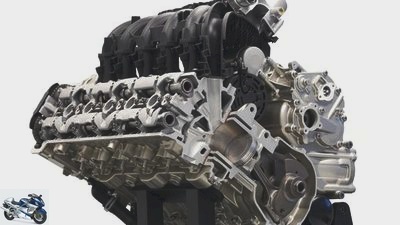
Bilski
The cut open BMW six-cylinder.
! Mattes: Of course it played a role that the in-line six-cylinder is a tradition at BMW in the automotive sector. But this is also the ideal drive because of the functional properties such as smooth running, mass balancing and inertia forces.
? And that outweighs the design disadvantages such as weight and dimensions, which are particularly important in the motorcycle?
! Mattes: Yes, because in the end, when you drive the engines and vehicles, the straight six is another giant leap, especially when it comes to smoothness. A four-cylinder with a balancer shaft does not achieve the level of vibration and smoothness of the six-cylinder. It was certainly not a single argument, but the sum of the six-cylinder properties combined with the desired compactness – that was exactly the key.
? And the higher fuel consumption didn’t scare you?
! Mattes: It was always clear to us that the fuel consumption had to be a positive surprise. So we have placed a special focus on ensuring that it can absolutely keep up with the four-cylinder units, even though the six-cylinder inherently has a starting disadvantage due to more bearings and more friction.
? Now we have spoken of the six-cylinder and, alternatively, of the turbocharged four-cylinder. What was still up for debate??
! Hege: There are of course no upper limits to the number of cylinders. At least if you can just spin around. Then you can think of anything between six and twelve cylinders.
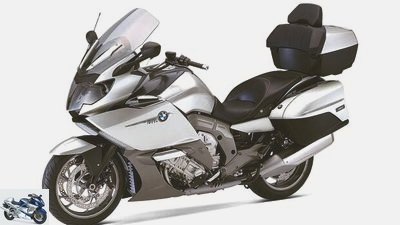
Bilski
This is what it looks like, the new K 1600, which will be available in the sportier GT and GTL versions (in the picture). Both have in common: the in-line six-cylinder.
? A twelve-cylinder?
! Mattes: There are two motors that are very good in terms of vibration. It’s the straight six and the V12 (laughs). Everything in between is a compromise.
! Hege: If you will, we actually downsized, even if not in a cylinder-like manner. The original approaches for such a super tourer were with larger engines. Two liters of displacement and something like that. Seen in this way, the six-cylinder is dainty.
? A 1600 series six in a motorcycle? You can also call that powerful.
! Hege: That’s why the disadvantages weren’t allowed to show through.
? At least when it comes to weight, that didn’t really work out. At 102 kilograms, the six-cylinder weighs around 25 kilograms more than the four-cylinder in the K 1300 GT!
! Hege: That’s true, but you have to make fair comparisons. We have a lot more torque, which requires a new and heavier gearbox. The same applies to the clutch and the power transmission in general.
? What does that mean in kilograms?
! Hege: We’d have to add a good half of the extra weight to the four-cylinder with the same torque. Between ten and 15 kilograms. Nevertheless, we stressed the subject of lightweight construction quite a bit. The crankshaft weighs only 12.9 kilograms, although we have built in as much moment of inertia as possible, which in turn helps the engine run smoothly. For comparison: the four-cylinder shaft already weighs eleven kilograms.
! Mattes: The camshaft is also an innovation in motorcycle construction. This is a built-up camshaft with a wall thickness of three millimeters. A steel tube onto which the cams are pressed in a form-fitting manner. And that makes it very easy, of course. As well as the engine cover, by the way. The cylinder head cover, the clutch cover – all magnesium. Plus plastic wherever possible. In terms of weight, this engine is technically optimized for this torque level.

Bilski
Wolfgang Mattes: The 45-year-old engineer has been with BMW since 1991 and worked there in car engine development until 2009. Since then he has been Head of Drive Development at BMW Motorrad.
? There was never any thought of helping oneself to a certain extent in the BMW auto department?
! Hege: Yes, of course. When we first considered how we should design the crankshaft, we got together with our colleagues in the car.
? But you weren’t poached on the parts shelf?
! Mattes: That’s often the approach, but there are a few fundamental differences between motorcycle and car drives. A few examples: The gearbox is integrated in a motorcycle. In the case of a car engine, we always use a flange-mounted gearbox. You can’t fit that into the motorcycle. Then all drives for the ancillary units in the motorcycle, such as the water pump or alternator, are beltless. Not least because the motorcycle engine is exposed, which also assigns a central role to the topic of surface coatings and value. If you take a car engine under these conditions and redesign it, then in the end it will be an engine of its own.
? The bottom line is that it costs a lot. The cost of the six-cylinder was a problem?
! Hege: One thing is very clear: six pistons cost more than four. We tried to compensate for that. With new suppliers, for example, who also work with the passenger car sector.
? Nevertheless, there was a point at which the project threatened to fail due to financial considerations?
! Mattes: When you start a development, everything is always red at the beginning. You have neither the cost together nor the features. There is no such thing as developing something new and achieving all goals right from the start. That is exactly the development work, the transpiration of the implementation, as I call it.
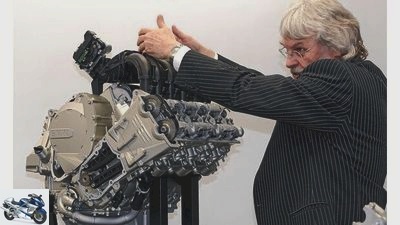
Bilski
Heinz Hege: The 58-year-old has been with BMW Motorrad since 1978. From 1986 he headed the engine design department, from 2003 to 2006 the vehicle concepts department. Then he took over the development of the six-cylinder.
? In what time frame do you have to imagine this development work?
! Hege: At the beginning of 2006, the decision was made that we wanted to develop the six-cylinder concept towards series production. The detailed construction – for example, how the crankshaft should look exactly – then started in August. Then it takes another six months before the prototype parts are obtained and the first engines are built. Then came the functional tests and they began with very central topics. The first thing that has to work is the oil circuit, for example.
? In other words, from this point onwards, such an engine will run on the test bench?
! Mattes: Yes, of course that is very exciting.
? When was that with this engine??
! Hege: beginning of October 2007.
! Mattes: Then you slowly feel your way forward and also run the first endurance runs with the first prototype engines in order to identify any weak points. The current technical status is then shown in two to three loops – we call this construction stages. When you have reached a certain degree of maturity, you get in touch with the suppliers and coordinate the production-related issues.
? How much time has passed until this point?
! Mattes: About half a year for the basic considerations, half a year for the detailed designs, half a year for the parts procurement, a good year for testing and development. And then the industrialization phase begins, in which you talk to suppliers, strengthen the factory processes and carry out the final tests with series parts. This usually takes another year and a half.
? Did the engine concept have a single throttle valve from the outset, or a conventional motorcycle arrangement with six throttle valves was also being tested?
! Hege: No, right at the beginning we had two throttle bodies. Six was never an issue. If you want to connect six throttle bodies, you need a huge overall width. This is not possible with this vehicle concept, in which the frame virtually encloses the engine. You’ll get way too wide in this area. You will notice that once you have sat on one of the old six-cylinders like the Kawasaki Z 1300.
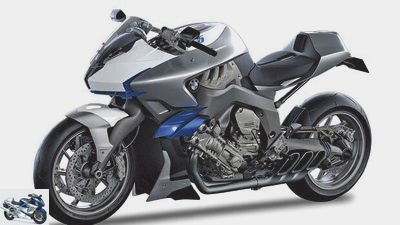
Bilski
Just speculation? This “concept 6” The study with the 1600 series caused a sensation at the Milan trade fair in 2009.
? If you look at such an old construction when you start in 2003?
! Hege: Well, I did it.
? Keyword concept 6 study: This engine will also succeed in a naked bike?
! Mattes: This is now a speculation on your part.
? Okay, next question: Does this motor still have room for improvement in terms of bore? With a wall thickness of only five millimeters between the holes?
! Mattes: When you make a new engine, you think about what potential you give it. You won’t be lying on the edge the first time you bring in the engine. There are still reserves, even if they are not infinite.
? But right now you should be well positioned with this engine compared to the strong competition, right??
! Mattes: Of course, especially when it comes to pulling through. We are significantly better than our competitors in this regard. With this vehicle you can easily drive out of every bend in sixth gear at 900 rpm. It’s fascinating, you can’t do that with any other drive.
? Then you could have saved yourself the six-speed gearbox?
! Hege: Basically yes. However, this gives you the option of taking sixth gear a little longer and the range of uses for the motorcycle is even broader.
? The automatic would not have been a good match for this vehicle concept?
! Mattes: In principle, automation certainly has a future. But I have to honestly say: We didn’t plan too much at once for this project. Of course we have the topic of automation on the radar. We will bring BMW-specific solutions there.
? Last question: Will the 1300 four-cylinder and the 1600 six-cylinder run side by side in the long term?!
! Mattes: The K 1300 GT will be replaced by the K 1600 GT in 2011, while the 1300 R and 1300 S will continue to run.
Mr. Mattes, Mr. Hege, thank you for talking to us.
The conversation with Wolfgang Mattes and Heinz Hege was conducted by MOTORRAD editor Stefan Kaschel.
The six-cylinder performance
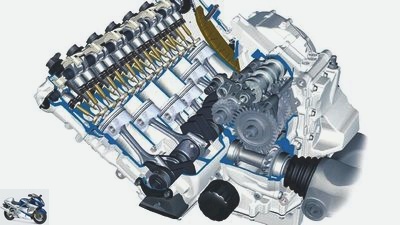
BMW
The sketch of the BMW six-cylinder.
When it comes to six-cylinder motorcycles, the overall width is the central issue. It is no different with the latest BMW development. The pursuit of compact dimensions does not only apply to the crankcase.
72 – with the new BMW six-cylinder, that’s the number that not everything, but almost everything, revolves around. The bore of the six cylinders is 72 millimeters. There are also five bars, each five millimeters wide, between the cylinders, as well as the timing chain slot and the two outer cylinder walls. In total, measured from the left engine cover to the right cylinder head screw connection (the outer measuring points), it is exactly 555 millimeters. A good half a meter. That’s not much for a straight-six. For comparison: the four-cylinder of the BMW K 1300 GT is only a good five centimeters narrower at 499 millimeters despite the smaller displacement.
Speaking of displacement: with a stroke of at least 67.5 millimeters, the result is 1649 cubic centimeters, and the bore-stroke ratio of the six-cylinder is clearly designed for torque rather than power.
This is also indicated by the solution, which is unusual in the motorcycle sector, with just one throttle body with a modest 52 millimeters diameter, as well as the long intake paths.
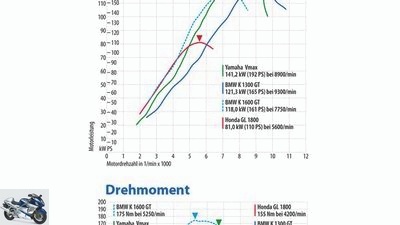
Drawing: archive
The diagrams of different six-cylinder.
And the four valves per cylinder are also rather delicate at 29 millimeters for the intake valves and 24.8 millimeters for the exhaust valves. Conventionally, however, the valve train via timing chain and bucket tappets.
The diagram on the right shows that the six-cylinder does not need high speeds. Compared to the other torque giants, the curve propagated by BMW clearly shows where the six-cylinder hammer hangs. Full torque in the lower and middle speed range, good performance at the top – these details make you want more. The steep increase in torque from around 4000 rpm (in the two driving modes “Road” and “dynamics”, while he’s in “Rain mode” smoother) results, according to engine developer Heinz Hege, from a kind of charging effect in the medium speed range, due to the long intake manifolds.
The compact design of the gearbox, on the other hand, is due to ergonomics. The two main transmission shafts moved upwards and to the left, the clutch moved inwards, a third transmission shaft underneath drives the cardan drive, the clutch water and oil pump as well as the generator and starter freewheel.
Technical specifications:
Water-cooled six-cylinder four-stroke in-line engine, two overhead, chain-driven camshafts, four valves per cylinder, bucket tappets, dry sump lubrication with integrated oil tank, a throttle valve, Ø 52 millimeters

Bilski
Christoph Dimter: The 60-year-old frequent driver developed transmissions at Porsche, drives a Kawasaki GTR 1400 and will soon be accompanying MOTORRAD in the top test of the K 1600.
MOTORRAD asked not only the makers, but also a potential customer: What does he expect from the new six-cylinder engine and transmission?
For me, the new K 1600 GT is the logical continuation of the search for the optimal compromise between comfort and sportiness after nine large-displacement motorcycles (most recently the Kawa GTR 1400). I expect a lot, if not everything, from the new six-cylinder in particular.
In detail: The motor must be a torque giant, whereby the maximum value is insignificant. Much more important is a torque surge at the lowest speeds. The second point is the highest level of smoothness and freedom from vibration across the entire speed range. Given the perfect mass balance of an in-line six-cylinder, that shouldn’t be a problem.
Thirdly, I expect an intoxicating six-cylinder in-line engine sound, in all situations. After all, with such an extraordinary motorcycle engine concept, the ear goes along with it.
Fourth, the response behavior of the six-cylinder, which practically shakes its performance out of its sleeve, should also be of the highest level. As well as the starting and idling behavior, by the way. Fifthly, the idling speed should be so low that the impact of first gear is practically no longer noticeable.
Sixth, I expect a perfect engine application for all driving conditions such as cold running, coasting mode, torque shock reduction after shifting and, and, and. And last but not least, acceptable fuel consumption and high reliability. If all of this succeeds (and the prerequisites are ideal) BMW would have a new (old) customer.
Related articles
-
2snap Sports & scene Motorsport Report: MotoGP technology The technology in the MotoGP class Stefan Bradl on the bikes in the premier class Content of…
-
BMW K model, new, for 2005: technology
MOTORCYCLE counselor technology & future BMW K model, new, for 2005: technology BMW K model, new, for 2005: technology The revealing Michael Pfeiffer…
-
PS reader question about motorcycle technology – cleaning the radiator
www.factstudio.de, Joachim Schahl 7th pictures archive 1/7 Picture gallery, technical question: cleaning coolers. Werner Koch 2/7 When the delicate…
-
Test and technology: Ten very cool machines with their owners
Daams Sports & scene Test and technology: Ten very cool machines with their owners The coolest motorcycles of the 2014 season Coal, coke and cool boxes…
-
Test & technology: Endurance test interim balance of the Ducati Multistrada 1200 S
Jahn motorcycles test &Technology: Endurance test interim balance of the Ducati Multistrada 1200 S Endurance test interim balance of the Ducati…
-
Technology of the 2002 model year
motorcycles Technology of the 2002 model year Technology of the 2002 model year Undercover In the 2002 season it is the inner values that count, and…
-
Superbike World Championship: technology of the Aprilia and Ducati factory machines
motorcycles Superbike World Championship: Technology of the Aprilia and Ducati factory machines Superbike World Championship: Technology of the Aprilia…
-
MV Agusta F3 engine: the technology
manufacturer counselor technology & future MV Agusta F3 engine: the technology Technology: MV Agusta F3 engine The engine of the super sports car from MV…
-
manufacturer 12th pictures manufacturer 1/12 The trick with the pressure: intake tract and intake manifolds. 2snap 2/12 Two louvers on the MotoGP Honda….
-
Technology: Seamless transmission from the Honda RC 213 V.
2snap Sports & scene Motorsport Technology: Seamless transmission from the Honda RC 213 V. MOTOGP technology seamless gear of the Honda RC 213 V Full…